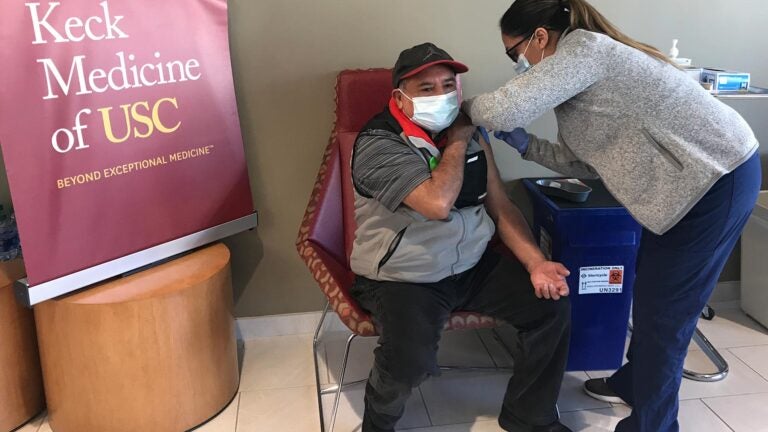
Sixto Cruz gets a COVID-19 vaccination during the Keck Medicine of USC clinic on Saturday. (USC Photo/Alison Rainey)
USC tackles vaccination inequities with community COVID-19 vaccine clinic
Keck Medicine of USC representatives worked with community leaders, went door to door and even set up a shuttle to help unvaccinated Los Angeles residents get their first shots.
Keck Medicine of USC nurses and USC School of Pharmacy students vaccinated more than 400 people from the Eastside of Los Angeles on Saturday to help counter disparities in COVID-19 inoculation.
Even though 43% percent of white and 39% of Asian American seniors have received at least one dose of the vaccine, just 29% of Latino and 24% of Black seniors have been vaccinated, according to the Los Angeles Times.
Los Angeles County officials said these disparities are due to long-standing issues related to residents’ access to health care and education. Wealthier and whiter communities have much higher vaccination rates in Los Angeles than lower-income, more diverse areas.
“Keck Medicine of USC is committed to increasing vaccination access to those in our nearby communities, many of which are predominantly Latino and African American,” said Felipe Osorno, executive administrator for continuum of care operations and value improvement at Keck Medicine.
“Given the disproportionate impact of COVID-19, vaccinating our community is incredibly important.”
USC COVID-19 vaccine clinic aimed at communities in need
Saturday’s Keck Medicine clinic, held on the USC Health Sciences Campus, was the result of extensive community outreach aimed at populations whose inoculation rates have fallen behind during the COVID-19 vaccine rollout.
The roughly 500 doses of the Pfizer vaccine were set aside at no charge to residents age 65 and older from eastern Los Angeles. This includes those who live in El Sereno, Boyle Heights and Highland Park, areas that are heavily Latino. Vaccines were also available to health care workers.
Keck Medicine worked with elected officials, churches, community centers, senior clubs and schools to spread the word.
Volunteers distributed flyers in multiple languages, walked door to door and even set up a shuttle from the Ramona Gardens public housing apartments to the Norris Healthcare Center on the Health Sciences Campus.
Among the outreach partners were:
- The offices of Supervisor Hilda L. Solis and City Councilman Kevin de Leon
- The Boyle Heights and Ramona senior clubs and the Pasadena and Betty Hill senior centers
- Faith groups, including Brown Memorial African Methodist Episcopal Church and St. Vincent, St. Francis and Sacred Heart Catholic churches
- Community-based organizations like Alma Family Services, YMCA Seniors and Variety Boys & Girls Club
- The Housing Authority of the city of Los Angeles
- Schools, including Francisco Bravo Medical Magnet, St. Agnes Parish, Vermont Avenue Elementary, El Sereno Middle, Hollenbeck Middle, East College Prep and Santa Teresita Elementary
Free clinic key step in combatting vaccination disparities
Keck Medicine administrators are committed to continuing partnerships with the city, county and nonprofit organizations to overcome vaccination disparities in Los Angeles County.
Data show wealthy areas have greater vaccination rates. For example, in Beverly Hills — where household income hovers at $109,000 per year — 25% of residents already have received the first vaccine dose. But in Boyle Heights, where the median income stands at $43,000, only 6% of residents can say the same, according to a Los Angeles Times analysis of U.S. and county data.
Eastside residents who received the Pfizer vaccine Saturday will have to go back to the site in 21 days for their second shot.
Keck Medicine of USC hopes to have similar free COVID vaccination clinics in the future.
Said Osorno: “We will continue to do outreach to neighboring communities of both Health Sciences and University Park campuses.”



